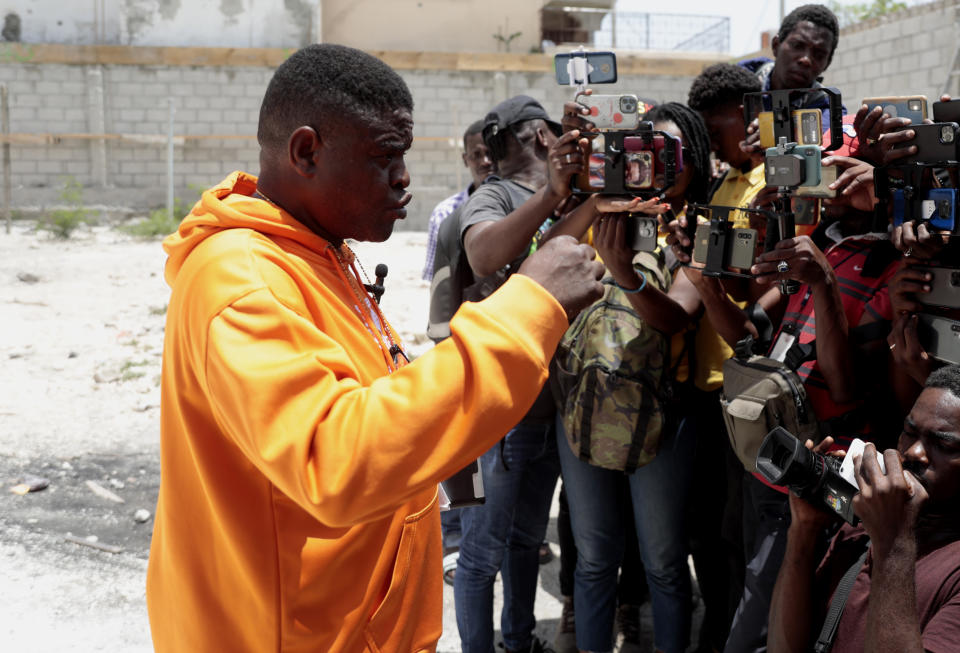The result of observing Songpadae with a thermal imaging camera on the roof of Songpa-gu Office. Provided by the Korea Meteorological Administration
During the heat wave, it was observed that there was a difference of more than 4 degrees between the daytime temperature between the park green area and the urban residential area in the same area. The Korea Meteorological Administration announced on the 17th that this summer, it measured the ground temperature at 1.5m above the ground and at eight points with different surrounding environments near Jamsil, Songpa-gu, using IoT weather observation sensors, where citizens actually feel the temperature. This observation was conducted with the purpose of supporting local governments to respond to urban heatwaves by analyzing the thermal environment felt by citizens according to the surrounding environmental conditions in the city. The Korea Meteorological Administration divided eight points into two regions: ① Asphalt ② Soil ③ Shade shelter ④ Bus stop (region 1 above) and ⑤ Park green area ⑥ Small park in the city center ⑦ City housing ⑧ Urban apartment (region 2), and observed for three days each.
Temperature observation using 8 points with different surrounding environments and thermal imaging cameras. Provided by the Korea Meteorological Administration ※ Click on the image to see it larger.
As a result of the measurement, on the last 4 days when the heat wave (the day when the daily maximum temperature was 33 degrees or more) occurred, the temperature at 1.5m above the ground was observed. It was about 4.1 degrees higher than the temperature of 33.6 degrees. The temperature was highest in the order of city houses, city apartments, city small parks, and parks and green spaces. Buildings are concentrated in the downtown residential area, the floor is made of asphalt and sidewalk blocks, and the temperature is high due to exposure to the sun all day. In the case of ‘region 1’, the temperature was highest in the order of bus stop, asphalt road, soil playground, and shade shelter. The bus stop in the middle of the road has a semi-closed structure, so the air flow is weak, and the asphalt road surrounds it, so there is little difference in average temperature with the asphalt. At all 8 points, a large temperature difference was observed between 1:00 pm and 3:00 pm according to the surrounding environment, and the increase in maximum temperature compared to the average temperature of asphalt, dirt floors, city houses, and apartments where sunlight directly hits was remarkable.
It was found that the maximum temperature of urban housing was 37.7 degrees Celsius, which was about 4 degrees higher than the maximum temperature of 33.6 degrees Celsius in parks and green areas. Provided by the Korea Meteorological Administration ※ Click on the image to see it larger.
Looking at the ground temperature measurement results, when the sun was shining, the highest temperature in places with concrete or block floors was 45 to 55 degrees or higher, and the temperature rise was large. The maximum temperature of the asphalt was up to 18.9 degrees higher than the maximum temperature of 1.5 meters above the ground, and 10.9 degrees and 9.2 degrees higher were observed for urban houses and apartments, respectively. On the other hand, the ground temperature compared to the air temperature in shade shelters and park green areas was observed to be similar or rather 2 to 3 degrees lower. The ground temperature of ‘Region 1’ was higher in the order of asphalt floor, dirt floor, bus stop, and shade shelter, and the bus stop was different from the highest temperature at 1.5m. This is because the bus stop and the shade shelter were less affected by solar radiation due to the roof and shade, and the ground temperature was observed to be lower than the temperature at 1.5m. The ground temperature ranking of ‘Zone 2’ was equal to 1.5 m.
Ground temperature observation results of ‘Region 2’ on July 7, August 1, and August 3. Provided by the Korea Meteorological Administration ※ Click on the image to see it larger.
In addition, as a result of observing Songpa-daero through a thermal imaging camera from the rooftop of Songpa-gu Office, it was observed that the temperature of the outer wall of the building was affected by the color of the outer wall. Depending on the direction of the building, around 11:00 a.m., when it receives a lot of solar radiation, the temperature of the exterior walls of black-colored buildings rises to about 46 degrees, which is more than 4 degrees higher than that of glass or white-type buildings. Roads and footpaths rose to a maximum of around 50 degrees between 2 and 3 pm, showing the highest temperature, and green areas maintained 30 to 35 degrees because the range of temperature change was not large. An official from the Korea Meteorological Administration said, “In case of a heat wave, avoiding sunlight as much as possible and staying in the shade at a park or rest area is helpful in preventing heat-related diseases.” “At this time, if you have to do gardening or sitting, you have to avoid the sun.” Reporter Ki Min-do [email protected]
2023-08-17 03:22:15
#Songpagu.. #difference #degrees #park #residential #area #heat #wave


